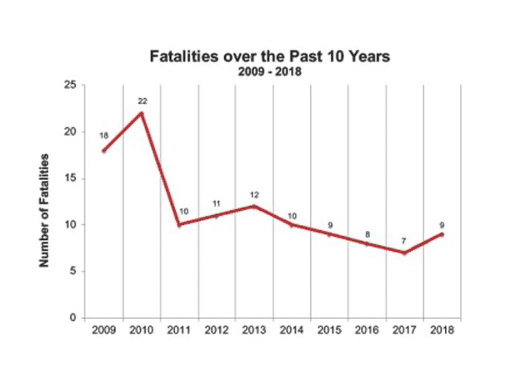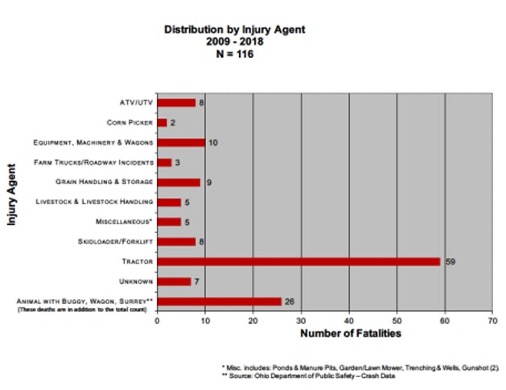Farm Safety
PRACTICING AGRICULTURAL SAFETY ON THE FARM
Your safety while working on or around the farm is of upmost importance to us. We want to ensure you are taking the necessary precautions whenever possible to keep you, your family and coworkers safe – your health, well-being and lives depend on it. It only takes a second for a tragedy to happen. Taking your time, keeping all guards in place, and avoiding shortcuts can be the difference from being healthy, injured or dead.
In 2019 alone, Ohio had 468 Medical Only Claims with an average cost of approximately $970 and 77 Lost Time Claims with an average cost of approximately $25,700.
We have outlined below some of the most common areas where agricultural and farm accidents occur, and tips on how to safely navigate tasks in these specific situations.



It is our goal to help provide you with the resources you need to keep yourself, your family and your workers safe on the job so that they can return home safely when the day is done. Click here for more agriculture safety information or continue reading.
SAFETY TIPS TO PREVENT AGRICULTURAL ACCIDENTS
CONFINED SPACES
There are many confined spaces on a farm, such as manure pits, grain bins, grain silos and manholes. When organic material is under decomposition, it can create various types of hazardous gases, such as:
- Hydrogen Sulfide – a very recognizable pungent gas (which smells like rotten eggs) until it reaches a level above 100 parts per million, in which it numbs our sense of smell is considered under NIOSH’s guidelines to be immediately dangerous to life and health.
- Methane – an odorless gas in its natural state. It is an explosive gas between 4.4-16.4% volume in air, hazardous to the human body prior to reaching 4.4%, and can also displace oxygen to dangerously low levels.
- Carbon Dioxide / Carbon Monoxide – colorless and odorless gases that can displace oxygen to dangerously low levels quickly and without warning.
- Ammonia – a very recognizable, pungent gas that is painful at elevated levels with an IDLH level of 300 ppm.
Atmospheric hazards can also exist outside of confined spaces, so it’s important to always use caution when working around decaying organic matter, such as manure, grain, silage, stalks, leaves, etc. Dust found within or outside of a confined space can also be a hazard regarding respiratory, fire and explosion.
We encourage you to consider utilizing gas meter equipment to detect these hazardous gas levels and means for non-entry rescue from an observer. Always call 911 for any emergency and never enter a confined space where someone is unresponsive.
PESTICIDES AND CHEMICALS
There are a wide range of pesticides and chemicals available to users. People who utilize these pesticides and chemicals should be sure to follow the label and safety data sheet information. Avoid any short and/or long-term complications by using proper personal protective equipment (PPE) such as respiratory, eye, and skin protection. And always contact the chemical manufacturer if you have any questions or concerns.
TOOLS AND EQUIPMENT
Tools and equipment can present many hazards on the farm such as being struct by, entanglement, electrical, cuts, etc. Entanglement or being caught in machinery can be prevented through locking out power and following the 6-step lockout/tagout procedures to stop another person from inadvertently turning it on.
- Placement of lockout/tagout device(s).
- Removal of lockout/tagout device(s).
- Replacement of safeguards, machine or equipment inspection and removal of all non-essential tools and equipment.
- Safe positioning of employees.
- Removal of lockout/tagout device(s).
- Notification of affected employees that servicing and maintenance is completed.
- Transfer of lockout/tagout devices during shift or personnel changes.
POWER TAKE OFF (PTO)
PTO’s can rotate at 1,000 rpm’s (16.6 times per second), making it important to always ensure proper guarding is in place when working around PTO’s. Most accidents involving PTO’s happen because of loose clothing such as shirts, pants, shoelaces, overalls, coveralls, etc. getting caught and pulling a person in. It is important that operators never cross over a guarded or unguarded PTO shaft – instead make sure you take the time to walk around.
ANHYDROUS AMMONIA
While not all farmers use anhydrous ammonia on their farm operations, there are a significant number of farmers that utilize this chemical as a nitrogen crop fertilizer. Anhydrous ammonia vaporizes to a colorless gas and has a unique odor that can be detected at levels as low as 5 ppm. When anhydrous ammonia concentration in storage and nurse tanks is greater than 995,000 ppm, human exposure is considered “Immediately Dangerous to Health and Life at 300 ppm.” When handling anhydrous ammonia, proper use and protection are critical as anhydrous can have detrimental effects to life, eyes, lungs, and skin.
Additional Resources:
TRACTOR SAFETY
Tractor accidents are the leading cause of death and injury for farmers and agricultural workers, accounting for approximately 70% of all farm accidents resulting in fatalities. Some of the most common tractor accidents causing serious injury are rollovers, runovers, moving parts and collisions. 53% of tractor fatalities are from rollovers alone. Here are a few safety measures to ALWAYS follow to help prevent tractor-related accidents:
- Wear a safety belt.
- Only start a tractor after you are seated in the operator’s seat.
- Keep hands, feet and clothing away from moving parts of the equipment.
- Use and maintain rollover protection equipment, such as safety belts, roll bars, etc.
- Be aware of tree limbs, vehicles and other barriers in the tractor’s path.
- Use extra caution when driving a tractor on a hill or slope.
Additional Resources:
HEAT STRESS
Heat stress includes a series of conditions where the body is under stress from overheating. Heat-related illnesses include heat cramps, heat exhaustion, heat rash or heat stroke – each condition having its own symptoms and treatments. Symptoms can range from profuse sweating to dizziness, cessation of sweating, and collapse. To keep you cool and prevent heat stress related accidents, follow the following guidelines.
- If you feel any of the symptoms noted above, be sure to get out of the heat quickly and into a
cool place or shade. - Wear loose-fitting, lightweight clothing.
- Stay hydrated.
- Schedule strenuous work for the morning or evening hours.
- Apply cool towels to your skin.
- If you have a chronic health condition or medications that could make you susceptible to heat stroke, consult your doctor.
